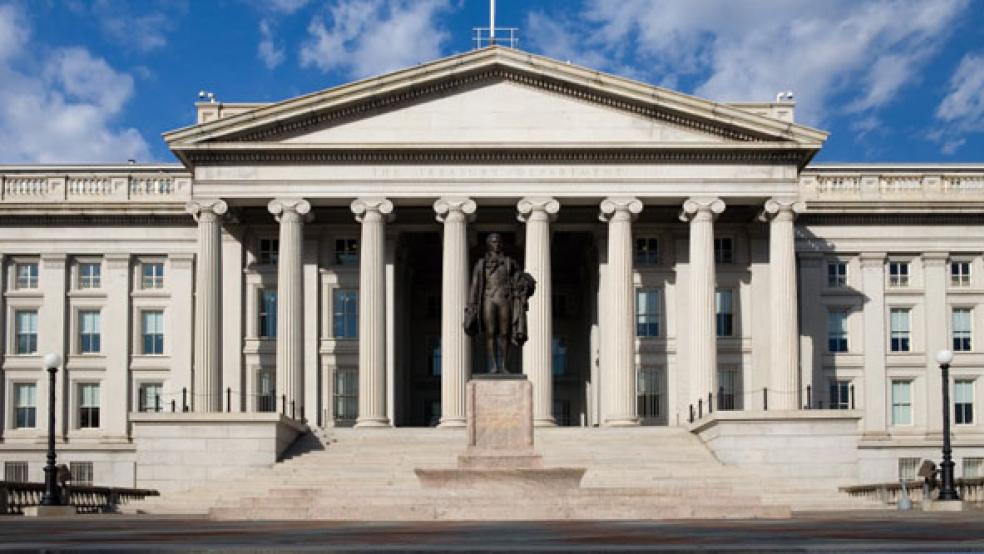The latest debt ceiling drama illustrates why the U.S. Treasury is not a triple-A-rated borrower. The fact that two of the big three rating agencies maintain top ratings on U.S. bonds suggests that the raters continue to exhibit biases exposed during the financial crisis.
In its Guide to Rating Symbols, Moody’s writes: “Obligations rated Aaa are judged to be of the highest quality, subject to the lowest level of credit risk.” Although this is not a very rigorous definition, Moody’s needed to get more precise when it started rating structured finance securities. The company published an idealized default probability table showing the likelihood of non-payment for any given rating for various time horizons. The table shows that a Aaa-rated debt security is supposed to have a one year default probability of 0.0001 percent. In other words, the chance that a bond issuer rated Aaa — like the U.S. Treasury — will fail to make debt payments on-time and in-full within the next 12 months is one in a million.
CBO estimates that the U.S. Treasury will run out of cash in early to mid-October if the debt ceiling isn’t raised. Once it runs out of cash, “the government would then be unable to pay its obligations fully, so it would have to delay making payments for its programs and activities, default on its debt obligations, or both.” With the expected cash exhaustion date now only about 20 legislative days away and with a dysfunctional Congress also facing a September 30 deadline to pass a continuing budget resolution, the risk that the debt ceiling won’t be raised on time is significant.
In this event, the Treasury could choose to prioritize principal and interest payments on bonds over other federal obligations like Social Security and veterans benefits or making its payroll. But Treasury Secretary Steve Mnuchin has expressed hostility to this idea. Further, although Treasury developed a payment prioritization plan during the 2011 debt ceiling crisis, this plan has never been tested. Given the example of the HealthCare.gov rollout, an operational failure on the part of the federal government is a real possibility.
For a bond default to occur, both negative outcomes outlined above would have to happen. First, Congress and the administration would have to fail to raise the debt ceiling. Then, Treasury would have to fail to prioritize bond payments. Let’s say that each of these outcomes has a 5 percent chance of occurring. That means the chance of default is 5 percent of 5 percent, or 0.25 percent — a number way above the 0.0001 percent Moody’s has associated with its top Aaa rating.
In 2013, Moody’s downgraded the United Kingdom to Aa1, its second highest rating. The U.S. and the U.K. have similar debt-to-GDP ratios and both countries issue debt in their own currencies, giving them the ability to make debt payments by printing money. While it is true that the U.S. has a bigger and more diversified economy, the U.K. has an important advantage over us: It lacks a legal debt ceiling, and so its government does not have to stage a kabuki dance every couple of years when the limit is reached.
A debtor’s credit quality is not only based on its ability to pay but also its willingness to pay. In the U.S., legislators have the power to stop debt payments and many have shown an interest in exercising that power to make one or another political point. Even President Obama, back when he was a U.S. senator, voted against a debt ceiling increase. So, Moody’s relative assessments of the U.K. and U.S. are hard to fathom — in the absence of commercial biases.
A Spotty Payment Record
Another factor that should differentiate Aaa bond issuers from the rest of the pack is a stellar credit history. Borrowers who consistently pay their bills on time can reasonably be expected to continue doing so. And if you listen to our political leaders and mainstream media, you may falsely conclude that America’s credit record is clean. During the 2011 debt ceiling crisis, President Obama said: "We have never defaulted on our debt and we are not going to do it now." Steve Mnuchin’s Treasury Department agrees, stating on its website that a federal government default on its legal obligations would be “an unprecedented event in American history.”
Unfortunately, this often-repeated meme is not true: the U.S. government has defaulted on multiple occasions. The first default was in 1782, just six years after the nation’s founding. But perhaps we could exclude that case because our country was not operating under our present Constitution at the time (Treasury Secretary Alexander Hamilton resolved the nation’s first debt crisis in 1790).
But as a detailed report from the Congressional Research Service shows, the U.S. has had three default episodes since the Constitution took effect. In 1814, the federal government failed to make interest payments as it struggled to meet obligations arising from the War of 1812. During the Depression, the Roosevelt administration welshed on the gold clause that gave bondholders the option to redeem their certificates for U.S. dollars or for gold based on an exchange rate of $20.67 per ounce. Gold redemptions were refused and the dollar was devalued to $35 per ounce of gold. Finally, in April and May 1979, Treasury did not mail interest and principal checks to many small investors on time. Although the problem seems to have been the result of a relocation and a failure of new word processing equipment, Treasury blamed Congress for delaying passage of a debt ceiling increase that year.
So Where Are the Rating Agencies?
During the 2011 debt ceiling crisis, S&P downgraded the U.S. government from AAA to AA+, its second highest rating on a scale of 21 grades. A downgrade of this magnitude is not a prediction of default, but simply a recognition that U.S. government fiscal management is sufficiently lax that a payment failure is within the realm of possibility.
S&P faced withering criticism for its decision back then — and, judging by interest rates on U.S. Treasuries, the markets shrugged off the downgrade — but the current situation shows that it made the right call. Given the potential enforcement actions rating agencies were facing from the federal government at the time, S&P’s downgrade was also an unusual act of corporate courage: affirming the intellectual integrity of its sovereign rating process despite the poor performance of its structured finance team and the ridicule it was encountering.
Since then S&P has paid $1.5 billion in fines while Moody’s disgorged only $864 million for similar ratings misbehavior. The difference may be seen as a cost S&P paid for exercising its commercial freedom of speech in 2011 (a contention denied by the Obama administration).
But at least S&P ratings analysts no longer have to twist themselves into an intellectual pretzel to justify an inflated U.S. government credit rating. Moody’s and smaller rival Fitch have no such luxury. Moody’s most recent release on the U.S. debt ceiling situation included the following:
At the time of publication, the Congress has not yet agreed to raise the debt ceiling. In this particular respect, the stable outlook on the US's Aaa rating reflects Moody's view that the debt ceiling will ultimately be raised, and that, even if it were not, the probability of the US missing a debt payment is low. Should the debt ceiling not be raised by the time the extraordinary measures are exhausted, we expect that interest payments on debt will be prioritized. As Moody's has indicated in the past, failure to meet a debt payment would have negative rating implications.
So, Moody’s won’t consider downgrading the U.S. unless and until it actually defaults. That defeats the purpose of a credit rating, which is to inform investors about the likelihood of future defaults and credit losses. With the financial crisis now firmly in the rearview mirror, one would hope that all three agencies would no longer be scared to do their job.
Marc Joffe was formerly a Senior Director at Moody’s Analytics. His role did not involve the assignment of credit ratings.






